Boost
SUNDAY, FEBRUARY 19, 2023

SUNDAY, FEBRUARY 19, 2023
After more than five years of diligent and detailed planning, painstaking preparation and countless hours of testing, it all comes down to one crucial weekend in early March for Queen Creek officials.
A new utility billing system will soon kick off when town utility customers receive a
printed bill in early March that they can’t pay electronically until March 7 when the new system goes live.

Town officials worry that could create confusion if people try to pay their bill too soon.
“Those will be our dark days,” Kristy Riester, town billing and customer service manager told the Transportation Advisory Committee this month.

“At the end of business on March 1, everything will shut down,” she said. “We’ll be
dark on the 2nd, which is a Thursday, obviously through the weekend and then Monday the 6th, we will not be able to take any payments. If we receive anything (in person) we’re just going to keep them in the safe and process them on March 7, when we go live in our system.”
The new system is will better meet the needs of Queen Creek’s utility service area,

see UTILITIES page 7
Amid the chilly winter December nights and onslaught of the pandemic, seven Queen Creek Girl Scouts began work on a project that will now warm the hearts and spirits of everyone at Mountain Vista Medical Center in East Mesa.

Their work led to the recent opening of Mountain Vista’s Sunshine Therapy Garden on its grounds, 1301 S. Crismon Road.

During the pandemic, Troop 3632 members Kayla Porter, Madi Roberts, Isabella Ronning, Chloe Copeland, Addie Bernier, and Ally and Lizzy Small spent many days with their families outside of the hospital’s intensive care unit.
There, they talked and prayed with pa-




































 BY MARK MORAN Tribune Staff Writer
BY MARK MORAN Tribune Staff Writer
On the heels of awarding a 2% pay raise that is bringing its teachers’ base salary up to $53,000, Queen Creek Unified School District is holding a teacher job fair to hire more classroom teachers for its growing student population.
The job fair – 4-7 p.m. Wednesday, Feb. 22, at the district office, 20217 E. Chandler Heights Road – aims to fill 40 vacancies, according to Keegan Bassett, director of human resources, who stressed that number is always changing based on attrition.
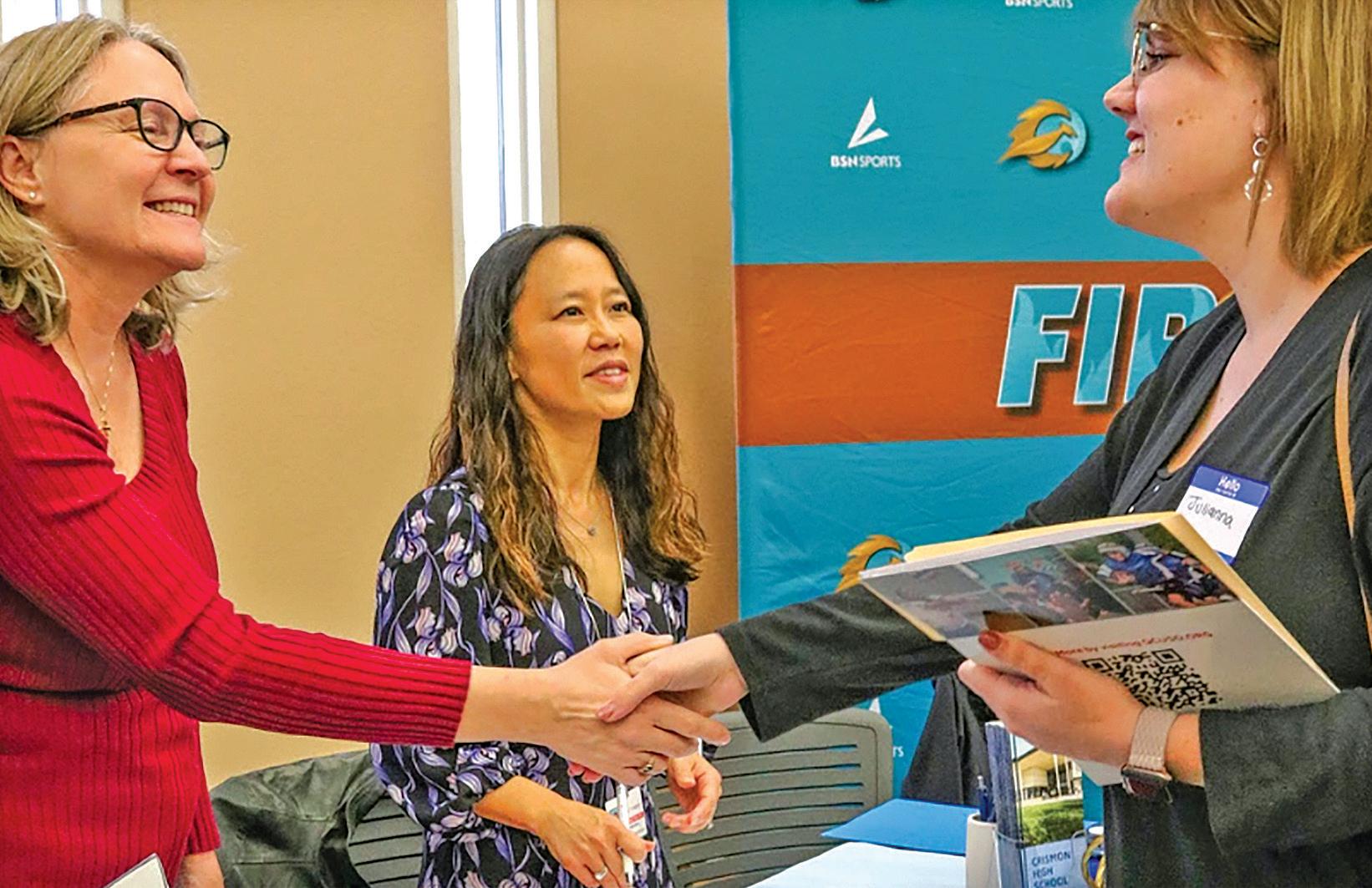

“It’s a very competitive market,” Bassett said. “That’s why we’re always trying to figure out ways we can leverage our resources … to make sure that we are capturing available prospective educators that best meet the needs of our students.”


Queen Creek employs about 700 teachers, and in addition to competing with other districts, the district also confronts the constant challenge that all of Queen Creek’s public services are facing.


“With attrition we’re going to get some resignations, some retirees, but in Queen Creek, the vast majority of our vacancies end up being due to the growth and the












need to open up new classrooms sections at school sites,” Bassett said.
Schools across the state are struggling to fill teacher vacancies and districts
have been trying to close the gap with a series of pay raises, using money from a $5-billion state budget surplus earmarked for K-12 classrooms.

According to Applied Economics, a demographer hired by the Queen Creek district, student growth is here to stay for the foreseeable future with 600 new students expected for the coming school year alone, according to district Chief Financial Officer Jennifer Johnston.




“Due to the growth that we are experiencing in our student population, the hiring of additional certified and classified staff will be necessary for next year,” Johnston said.
“Teachers are our greatest resource,” school board member James Knox said after the board approved the 2% teacher pay hike.
That was the latest in a series of seven pay raises Queen Creek has awarded its teachers, who got a 5% hike last September.

The unbridled growth is being felt be-


CONTACT INFORMATION
Main number: 480-898-6500
Advertising: 480-898-5624
Circulation: 480-898-5641
Publisher: Steve T. Strickbine
Vice President: Michael Hiatt
ADVERTISING DEPARTMENT
Display Advertising: 480-898-6309
Classifieds/Inside Sales: TJ Higgins | 480-898-5902 tjhiggins@TimesLocalMedia.com
Steve Insalaco | 480-898-5635 sinsalaco@TimesLocalMedia.com
Advertising Sales Executive: Jane Meyer | 480-898-5633 jane@TimesLocalMedia.com
NEWS DEPARTMENT Executive Editor: Paul Maryniak | 480-898-5647 pmaryniak@TimesLocalMedia.com
Managing Editor: Cecilia Chan | 480-898-5613 cchan@TimesLocalMedia.com
Reporters: Mark Moran | 480-898-5601 | mmoran@TimesLocalMedia.com
Ken Sain | 928-420-5341 ksain@TimesLocalMedia.com
Sports Editor: Zach Alvira | 480-898-5630 | zalvira@ TimesLocalMedia.com
Photographer: Dave Minton | dminton@TimesLocalMedia.com
Design/Production Supervisor: Shannon Mead | smead@TimesLocalMedia.com
Design: Ruth Carlton | rcarlton@TimesLocalMedia.com


Circulation: 623-535-8439
Circulation Director: Aaron Kolodny | aaron@phoenix.org
Distribution Manager: Brian Juhl | brian@timeslocalmedia.com


State lawmakers are moving to wrest control of transportation planning from local officials to instead represent their own political philosophies. And now the question is whose vision among all those lawmakers should take effect.
Strictly speaking, the debate on SB 1122 deals with whether Maricopa County voters will get a chance to extend a half-cent sales tax for transportation projects for another 20 years.
That can happen only with permission of the Republican-controlled Legislature. And several GOP lawmakers said they will give the go-ahead only if the amount set aside for mass transit is reduced from current levels – and if absolutely none of that goes to fund light rail.
For the moment, the 4-3 vote on Feb. 13 to kill SB 1122 by the Senate Committee on Transportation and Technology quashes any future election.
The Maricopa levy is set to expire in 2025 unless lawmakers give the goahead for an election.
Last week’s debate and vote show that any county that wants to fund transit projects will get the necessary legislative approval to ask their own voters for approval only if the plan complies with how state lawmakers agree how the money should be spent.
And that has become tainted by political philosophies, including a specific bias toward roads at the expense of mass transit and light rail in particular.
Sen. Frank Carroll, R-Sun City, has backed a broader approach with continued funding for alternatives to freeway construction. That’s the plan prepared by and backed by the Maricopa Association of Governments, made up of elected officials of all area cities, tribes and the urban areas of the Maricopa and Pima counties.
But Sen. Jake Hoffman, R-Queen Creek, rejected that as being driven by “nudge theory.’’
“It’s a tactic the Left likes to use called
‘choice architecture,’‘’ he said, essentially forcing people to accept the policies desired by those setting the rules.
Hoffman said that’s what’s happening under President Biden by shutting down the Keystone Pipeline, curtailing offshore drilling and refusing to renew some lease permits for drilling in Alaska.
“The Left is making a concerted effort to drive up the cost of gas,’’ he argued, to advance its agenda of reducing driving and emissions.
But Carroll, who supports more money for mass transit – and even sponsored a bill continuing dollars for light rail – said while that may be true, it’s also irrelevant. He said the gas prices are a reality for taxpayers.
“They’ve still got to get to work, they’ve still got to get to places,’’ Carroll said. And that, he said, makes it logical to assume that ridership on mass transit will increase with higher gas prices.
The more over-arching question is whether lawmakers, being pushed by groups like the Home Builders Association of Central Arizona whose members are developing housing projects farther from the county’s urban core, know better than local elected officials what their constituents want.
Avondale Mayor Kenn Weise, who chairs MAG, acknowledged that not every community benefits from each part of the regionally developed plan. For example, he said, his residents would not be aided by light rail which doesn’t extend into his community.
But he said the plan was unanimously adopted after “extensive public input’’ as being the best for all concerned.
In fact, state lawmakers agreed last year to put that on the ballot. But that was quashed when then-Gov. Doug Ducey vetoed even letting the issue go to voters.
That resulted in this year’s new and sharply modified plan, with more of the share going to pavement.
What the Legislature wants to do, Weise said, is override the locally adopted plan with its own priorities and those of “special interests,’’ meaning groups who would benefit financially by financing more road-construction rather than transit.
MAG wants lawmakers to simply give
As he appeared Feb. 14 before the state House Education Committee, state Rep. Travis Grantham bluntly told members that he wasn’t happy last year when he was assigned to the task force on teen mental health that had brought him before them.
“In the last session, I was asked to serve on an ad hoc committee dealing with teen mental health,” the Gilbert Republican told his colleagues. “And to be honest with you, I didn’t want to. But once I got on the committee and I understood how important of an issue this is, I changed my mind.”
Grantham had been appointed with then-state Rep. Joanne Osborne, R-Goodyear, to co-chair a committee that would “take a substantive look into the issues and causes affecting teen mental health, including substance abuse, depression, and suicide, and to identify potential solutions and improvements.”
From September through November, that panel – comprising police, school officials and various medical experts –heard at times gut-wrenching testimony about the rising incidents of drug overdoses, substance abuse, suicides and attempted suicides among teenagers in Arizona.
That panel produced 23 recommendations and Grantham in the committee’s first meeting warned members and the audience they shouldn’t get their hopes up.

Grantham warned the panel and people in the audience against unrealistic hopes for the committee’s work.
“There was an understanding that while mental health can be addressed and can be changed and for the better,” he said, “it’s like steering a ship: you turn the wheel and over time, the ship slowly starts to move, hopefully, in the right direction. It’s not an overnight fix.”
And though he echoed those cautionary remarks in the task force’s final meeting in December, he appeared before the House committee last week as
a crusader.
“I heard stories that quite honestly made me want to cry and formed a new appreciation for the folks who are the professionals in this industry who work so hard to try to solve these problems and the people who deal with this on a day to day basis,” he said.
A tragedy also struck closer to home for Grantham.
A female sophomore at a Gilbert private school died by suicide only a day earlier.
“We had an incident in my own district just a couple days ago where a young woman (died by) suicide and it set the school in a crisis mode,” Grantham told the committee.
“And I’m sure it’s affected a lot of her friends and the people who knew her. And every time a student or a young person does that, we lose tremendously and it’s devastating,” he said.
“I can’t tell you that this legislation will change the social aspect of the family or whatever might be weighing on these people that are choosing to go
down this road or having mental health issues, but at least it provides the opportunity for help to be there at the push of a button.”
The legislation he was referring to was the first – and probably easiest – of three bills he has filed to help push Arizona into a more proactive response to a crisis that has been aggravated by pandemic school closures, social media, bullying and other peer pressures.
He won when the committee voted to send to the House a measure that would allow school districts to develop or buy an app that would enable students to anonymously report safety issues ranging from self-harm to threats against students and receive anonymous clinical support 24/7.
The app also would provide students and parents with resources on mental health, bullying and substance abuse issues. It does not require districts to provide such an app but rather clears any administrative hurdles that might
110” wide x 95” high List Price $12,858
SALE $6,429
We offer a large group of beautiful customizable office models. These models have a wide range of colors and style options. SALE ENDS 2/28/23
TRANSPORTATION from page 4

voters a chance to approve the plan it created, the votes that adopted the tax and the first 20-year plan in 1985 and its renewal in 2005.


Weise rejected Hoffman’s suggestion of two separate votes: One on road construction and the other on mass transit. That, he said, would destroy the idea of having a plan where everyone recognizes the needs of the larger community.


He said that’s what enabled the MAG plan to include money for extension of State Route 24 in Hoffman’s district even though his own residents might otherwise have wanted dollars for a new State Route 30 to funnel traffic into his own area of the county.



Hoffman and some other lawmakers also want to insert other political elements before giving local voters permission to vote on transit funding.
For example, he wants to say that projects cannot be developed to fit “demand management’’ policies to reduce vehicle miles traveled. And he said he is not bothered if that means giving up federal dollars, a large share of transit funding that the state and counties receive.
The committee’s vote leaves in limbo the question of whether Maricopa County voters will get a chance to enact or extend existing taxes for their transportation plans if they do not meet with approval of a majority of lawmakers.
MENTAL from page 5




be preventing one from being offered, Grantham stressed.






Grantham’s other bills would create a teen mental health program within the state Department of Health Services and provide a so-far unspecified amount of money to fund its operation.

Such a program – which Osborne suggested could be funded with some of the $14 million Arizona will receive from the settlement of its lawsuit against Juul for a marketing campaign that led millions of children and teen into vaping addictions – could help pay for school district programs like the app.
Grantham’s bill would empower DHS to also pay school districts and nonprofits for training on mental health first aid, youth resiliency and substance abuse for staff, parents and peers.
It also would require the Health Services Department to make an annual report on projects it funded and the outcomes it achieved.
Grantham’s appearance also comes on the heels of a Chandler Unified School District report that disclosed 395 district students had considered suicide since July – and those are just the ones that officials know about.
Before the House committee took its unanimous vote, Osborne also addressed the crisis, noting that Grantham, a major in the Arizona Air National

Guard, knows all too well about the “horrendous” suicide rate among military veterans in the United States. The Guard uses the app the committee voted on to







the full House.
She then cited a new report by the Centers of Disease Control last week that said 57% of adolescent girls “feel persistently sad or hopeless.”
“That’s the highest rate in a decade and 30% said they have seriously considered dying by suicide, a percentage that has risen by nearly 60% over the past 10 years,” Osborne said.

“We have a crisis. It’s not an answer from one bill. It’s not an answer from one organization or one group or one teacher. It’s all of us. As parents, it’s our churches. It’s our schools. It’s our communities. We’ve got to recognize this because our kids don’t have five years for us to wake up as adults and say we got a problem here.
“It’s at our doorstep right now. And it’s affecting every one of our districts. There is no social, economic or whatever to it. Kids are having trouble.”

UTILITIES from page 1
she said.
“It’s very robust,” she said. “I think the community is going to see a lot of really great improvements. We have been working day and night.”
The customer portal will feature updated technology and enhanced service features – including access to water consumption and payment history, the ability to sign up for utility-related alerts, and the option of starting or transferring service.
She said while the new system will allow people to track consumption for a billing cycle, it will not yet be quite capable of reflecting real-time utility usage.
“We’re working towards that,” Riester said. “That will be part of our phase two, which will be awesome to get that live data.”
Riester said the length of the billing period reflected on customers’ new statements could vary between three and five weeks, but only in the first cycle.

Beyond a new account number and an upgraded online portal, there will be other changes designed to streamline paying residential utility bills.
“You will have a customer number and then an account number,” Riester said. “Your customer number will stay with you forever. If you move from one home to another home, you will keep your customer number. It will never change. It will stay the same.”
Riester said both the account and customer numbers are required on future mailed payments.
The new system requires customers using auto pay or paperless billing
to re-enroll. Residents using bill paythrough their bank and pay by phone will still have those options available, but will need to provide their account numbers when they log in.

Riester recommends writing down the account number to make re-registering easier for all payment options when the new system goes live on March 7.

Riester said the town also is encouraging all residents to opt for an electronic payment option.
“It saves the town a considerable amount of money,” she said. “That would be great if everyone signed up for paperless billing.”
At this point, the town is not adjusting rates.
“Customer rates are not changing,” said a statement from the town. “This is an upgrade to the town’s utility billing system. All Queen Creek utility customers will be impacted by the transition.”
Help will be available for anyone who needs it, Riester said, to avoid any mixups during “the dark days” between March 2-6.
“We will be here in the office,” she said. “We’ll be able to answer calls if customers have questions or need any information.” To
Legislation awaiting a House vote would override most local ordinances that now keep poultry out of many residential areas and allow for more chickens that Chandler’s new ordinance does.

The measure is being pushed by Rep. Kevin Payne, R-Peoria, would allow residents to keep up to nine birds – four more than Chandler allows –as long as they comply with certain conditions. But like Chandler’s ordinance, it would not supersede HOA rules against chicken coops.
“Chickens are loving birds,’’ Payne told members of the House Committee on Land, Agriculture and Rural Affairs last week, likening it to having a pet.
“You can hold them,’’ he said. “They purr. They help soothe people.’’
Payne also said they “love to have company,’’ which is why his HB 2483 seeks to allow more than just a lone chicken. And then there’s the practical side.
“They produce eggs, the golden nuggets that come out,’’ he said.
Only thing is, not every community sees things the same way. And even in cities and counties that allow residents to have the birds, the rules are not uniform.
This would change all that.
In essence, the proposal said if you live in a single-family detached home, you can have chickens.
Still, there would be rules.
Noisy roosters are still poultrynon-grata.
Letting the chickens roam cage free on a lot of less than half an acre also would be off limits. Instead, they would have to be kept in an enclosure at the side or rear of the property at least 15 feet from a neighbor. And the pens could be no larger than 200 feet.
Then there would be requirements to maintain the pens and either pick up or compost the manure at least twice a week, and do it in a way to prevent insects.
There also are requirements to have


adequate overflow drainage for water sources and that food be stored in insect-proof and rodent-proof containers.
Glendale resident Shelly Honn urged lawmakers to approve the measure after she was forced to get rid of “the girls’’ in her yard. And she said efforts to get the city to change its ordinance proved unsuccessful.
Honn also told lawmakers they need to consider the issue in light of other events, ranging from fires at egg ranches to other disasters.
of eggs.
“Arizonans need some sort of food security,’’ Honn said.
“Some want to live sustainably,’’ she continued. “A small flock of chickens would go a long way with both of these.’’
Not everyone was enthusiastic.
Marshall Pimentel, lobbyist for the League of Arizona Cities and Towns said his organization is not opposed in concept. But he would like changes, like limiting chicken ownership to lots of more than a half acre, with a six-bird cap.
That would include incidents of bird flu which have required flocks to be destroyed. And that, in turn, has been one of the things that has driven up the price
see CHICKENS page 11
do that job. In addition, the district will pay for employees to earn their commercial driver’s license.
Lawmakers were not persuaded as they voted unanimously to approve the yond the classroom, too.
The State Facilities Oversight Board, which oversees school building construction and land purchases, gave Queen Creek preliminary approval for $70-million over two years for the construction of new schools, the expansion of existing ones and for the purchase of land for what will be a 1,000-student elementary school in elementary that will be the largest in the state.
Like other districts, Queen Creek also has been facing a shortage of school bus drivers and recently voted to award signing bonuses to people who are hired to
Employees who are hired to drive buses can garner a signing bonus of between $500 and $2,500, depending on the qualifications they already bring to the job.
Bassett said all 14 of Queen Creek’s schools will be represented at the teacher job fair, “including the special education and preschool departments,” he said.
“We like to view it as ‘Queen Creek is a desirable place to work’,” Bassett said. “And so, we are trying to set ourselves up for success by getting our district name and reputation out there for prospective employees to consider looking at Queen Creek.”


Attorney General Kris Mayes is investigating whether to try to block the proposed merger of the state’s two largest grocery chains.
Mayes said Thursday she wants to know what will be the effects of allowing the combination of Kroger Co., the parent of Smith’s and Fry’s Foods, with Albertsons Companies, which operates not just stores under its own name but purchased Safeway and all the stores that company owned in 2015.
It starts, she said, with whether that combination will be able to drive up prices for consumers who already are suffering under high inflation.
“The impacts of this merger, in particular at a time when people are struggling to pay for groceries and prices are high, could be huge,’’ she said.
Then there’s the question of whether the merged company will close stores, forcing some people to travel farther. And Mayes wants to know how all of this
would affect the 35,000 workers now employed by both.
Much of that, she said, will come from “listening sessions’’ her office will conduct to hear what Arizonans think of the deal and how it will affect them.
Mayes is not the only one looking at the deal announced last year.
The Federal Trade Commission is conducting an inquiry into the $24.6 billion deal where Kroger would purchase its competitor while a group of consumers has filed suit in California to block the deal.
Mayes, however, is focused more on what the combination of the two giants would mean here. In fact, she told Capitol Media Services that, on a per capita basis, the merger will have a greater effect on Arizonans than any other state.
What she’s able to do about it, however, remains to be seen.
State law forbids any “contract, combination or conspiracy by two or more persons in restraint of, or to monopolize trade or commerce.’’
What Mayes said she needs to study
is whether what the two grocery giants are doing, at least in Arizona, meets that definition.
“The people of Arizona have important input to make here, people who live in the neighborhoods where a Fry’s or a Safeway or a Smith’s could be shut down,’’ she said.
That goes not just to the question of whether the combined operation, no longer competing for customers with each other, would be free to raise prices. Mayes said that decisions by the new company to shutter some of the stores could mean much longer drives to get food.
But she said it isn’t just the people shopping there who might be affected.
“We’re going to be getting input from the dairy operators in Arizona and the farmers and cattle growers who are worried about the reduction in competition in Arizona and the reduction in the number of outlets for their products,’’ Mayes said.
The attorney general said she also wants to look at how many workers at the two companies will end up unem-
ployed if the deal goes through.
A spokesman for Albertsons said there would be no comment.
Kroger, in a statement, said the merger “provides meaningful, measurable benefit to all stakeholders, including lowering prices, providing more choices and establishing a more competitive alternative to large, non-union retailers.’’ That last comment is in reference to Walmart, though not all Kroger stores are unionized.
On a website set up by the two chains, Kroger CEO Rodney McMullen said the deal will “deliver superior value to customers, associates, communities and shareholders.’’
It also claims that after the deal is closed, Kroger will invest $500 million to lower prices, $1.3 billion into Albertsons stores “to enhance the customer experience,’’ and $1 billion “to continue raising associate wages and comprehensive benefits.’’
Mayes, for her part, said she wants details.
see GROCERY page 11
For Your Pet’s Everyday Dental Needs
For Your Pet’s Everyday Dental Needs
We offer a convenient and simple way for you to access high-quality, routine dental care for your pets.
We offer a convenient and simple way for you to access high-quality, routine dental care for your pets.


Oral and Dental Exams
Oral and Dental Exams
Professional Teeth Cleaning
Professional Teeth Cleaning
Periodontal Treatment
Periodontal Treatment
Dental Radiology
Dental Radiology

Tooth Extractions
Tooth Extractions
Oral Mass Biopsy
Oral Mass Biopsy
Tooth Fracture Evaluation
Tooth Fracture Evaluation
GARDEN from page 1
tients’ loved ones, The Girl Scouts were so moved by the plight the patients faced because of COVID-19 and pandemic restrictions. that they decided to do something meaningful.
“We just kind of felt pretty helpless –like, how can we help?” said Troop 3632 leader Darcy Small, whose daughter Ally was among the girls who created a therapy garden for patients, nurses and other hospital personnel.
The two-year project was born in December 2020 when the girls tried to visit the Mountain Vista ICU.
Initially, they had planned to show their respect and gratitude for workers as the night shift came on to relieve the day shift employees.
With candles in hand and songs picked out, Darcy said they didn’t know what to expect.
They arrived and found families watching their loved ones battling COVID-19 from outside their room window and seeing the medical workers with “agony in their faces,” Darcy recalled.
“The girls experienced secondhand what it was like to have a loved one going through that and also see the health care workers what they were going through,” she said.
The girls maintained their weekly vigil Friday nights for five months, handing out extra candles to families and singing hymns.
One night, Darcy said, a patient’s son asked if they had extra candles, and Darcy’s daughter Lizzy asked what their loved one’s favorite hymn was so they could sing it.
After singing “How Great Thou Art,” a relative told the girls their loved one was just taken off the ventilator and “would be going to heaven soon.”
“You think, these 12- and 13-year-olds, like how are they processing this,” Darcy said. “And one of them just said, ‘Can I pray over you guys?’”
“This family, their loved one and the amazing staff here was my personal inspiration for Sunshine Therapy,” Lizzy said.
The girls joined the family outside the ICU window to pray and have since become friends.
Darcy said similar moments got the girls thinking at the time about a future
for the gravel area outside the groundfloor ICU.
“They wanted it to be a place where anybody that’s at the hospital visiting can come out and get fresh air and vitamin D. Health care workers have a place to come catch their breath, and then family members have a place to gather,” Darcy said.
The seven girls, aged 12 and 13, brainstormed a few ideas that led them to “sunshine therapy.”
They worked with hospital administrators, submitted plans to the city and eventually raised $30,000 in monetary and material donations to build the garden.
Now 14 and 15, the girls have developed leadership skills through their project that have contributed to their advancement in the Girl Scouts, high school and in life, Darcy said.
“There for a while, I thought, ‘I don’t know if this is actually going to happen,’” Darcy said. “And these girls, they did not give up. They were like, ‘no, this hospital needs this.’”
Sunshine Therapy Garden has transformed the once-gravel lot into an area for a quick rest and rehabilitation, complete trees, plants, a seating area with tables and park benches, a canvas shade covering, trees, and over 400 rocks painted with “messages of hope, love and inspiration.”

Kristie Porter has worked as an Occupational Therapist at Mountain Vista for 13 years and said this garden brings a sense of comfort to those who need(ed) it most.
“They cared for us as healthcare providers and provided comfort to patients and families who were going through the worst times of their life,” Porter said. “By choosing to build this beautiful courtyard is a blessing to more people than they will ever know.”
Her daughter Kayla, who plans to study sports medicine in college, said she came up with the idea for a lamp post that “symbolizes the light God has shown through the darkness of COVID,” Kayla said. “I thought it would be special to have this displayed to encourage healthcare workers, patients and family members of this statement.”
Tami Shreve spoke at a dedication ceremony and said she spent much of December 2021 at Mountain Vista as a patient under Kristie’s care.
After she turned a corner in her recovery, she noticed the Girl Scout troop and learned about their project.
“In the middle of the world being turned upside down and everyone dealing with a virus that is absolutely unforgiving and not selective on who it chooses, they saw hope,” Shreve said.
Besides cookie sales, three donors helped make the project possible through financial and material donation. They included Tami Shreve’s Evening Entertainment Group, Baseline Trees and Ronning Landscaping.
Ally, who wants to be a veterinarian when she grows up, said she wants to bring hope and encouragement to those and keep their determination strong
when it may feel weak.
“It is our hope that when staff, families or patients might be needing some extra encouragement, one of these rocks will inspire them to not give up,” Ally said.
Darcy said she just hopes that people will see what the girls accomplished with this project and show the world that the kind gesture, no matter big or small, means a lot when it comes from the heart.
“I am so hopeful that by sharing this, it will give others inspiration to always be on the lookout for ways to help in the community, in small ways or big ways,” Darcy said. “I fully see these seven girls graduating from high school as a Girl Scout troop.”
Beyond that, she wants to hear not just from the corporations who will be getting questioned by her investigators, but from those living in the affected communities.
“I think there’s value involved in bringing to light what this potential merger means to the state of Arizona and offering a forum for Arizonans to express what it means to them,’’ Mayes said.
“We’re talking about neighborhoods that could experience the closure of a grocery store, entire communities that might have to drive 100 miles or more to get to a grocery store, and potentially the layoff of thousands of people,’’ she continued.
That gets into one of the details that Mayes wants and could affect any decision on whether there would be violations of Arizona’s antitrust laws.
In its announcement, the retailers said they are willing to divest up to 650 of the stores to overcome regulatory concerns. None of the possible locations have been announced.
But even if that happens, that is no guarantee the stores will stay open.
When Albertsons bought Safeway, it agreed to sell 146 stores to Haggen, a
CHICKENS
measure.
“With the cost of food nowadays, this is how families can afford good-quality protein,’’ said Rep. Gail Griffin, R-Hereford. There is one group left out of this: Residents of homeowner associations which can enact their own restrictions, regardless of local ordinances. Lawmakers could override HOA rules. And they’ve done that in the past. Consider the measures they have
regional grocer. But Haggen eventually went bankrupt and Albertson’s bought back many of the stores.
Then there’s the question of whether anyone would be willing to buy the stores the new company is willing to shed, what with the possibility they are likely to offer up those which are least profitable.
There is, however, a backup plan: If a buyer can’t be found for the stores the new company is willing to sell, there is an offer to create a spin-off, still owned by Albertsons shareholders, which would operate independently and compete with the newly merged operation.
The merger – and whether it violates state antitrust laws – isn’t occurring in a vacuum. that also needs to be considered is what competition would remain in Arizona.

Bashas’ operates 118 stores, mostly in Arizona, under that name as well as Food City and AJ’s Fine Foods.
Mayes said these will be conducted in the next few months, with her office probably having to make a decision on what action to take, if any, within six months. That should still be enough time to intercede given that the two companies are looking to finalize the deal sometime in 2024.
approved governing everything from allowing political signs to permitting them to fly certain flags like those honoring first responders or remembering prisoners of war.
In fact, there’s a bill this year awaiting Senate action to allow HOA residents to display “any historic version of the American flag, including the Betsy Ross flag, without regard to how the stars and stripes are arranged on the flag.’’ Payne’s measure, however, contains no similar override.
Mesa, AZ – When it comes to chronic pain and/ or neuropathy, the most common doctor-prescribed treatment is drugs like Gabapentin, Lyrica, Cymbalta, and Neurontin. The problem with antidepressants or anti-seizure medications like these is that they offer purely symptomatic relief, as opposed to targeting and treating the root of the problem. Worse, these drugs often trigger an onset of uncomfortable, painful, and sometimes harmful side effects.
The only way to effectively treat chronic pain and/or peripheral neuropathy is by targeting the source, which is the result of nerve damage owing to inadequate blood flow to the nerves in the hands and feet. This often causes weakness, numbness, balance problems. A lack of nutrients causes the nerves degenerate – an insidious
cannot survive, and thus, slowly die. This leads to those painful and frustrating consequences we were talking about earlier, like weakness, numbness, tingling, balance issues, and perhaps even a burning sensation.
The drugs your doctor might prescribe will temporarily conceal the problems, putting a “Band-Aid” over a situation that will only continue to deteriorate without further action.
Thankfully, Mesa is the birthplace of a brandnew facility that sheds new light on this pressing problem of peripheral neuropathy and chronic pain. The company is trailblazing the medical industry by replacing outdated drugs and symptomatic reprieves with an advanced machine that targets the root of the problem at hand.
1. Finding the underlying cause
2. Determining the extent of the nerve damage (above 95% nerve loss is rarely treatable)
3. The amount of treatment required for the patient’s unique condition
Aspen Medical in Mesa, AZ uses a state-of-the-art electric cell signaling systems worth $100,000.00.

Th is ground-breaking treatment is engineered to achieve the following, accompanied by advanced diagnostics and a basic skin biopsy to accurately analyze results:
1. Increases blood flow

2. Stimulates and strengthens small fiber nerves
3. Improves brain-based pain
The treatment works by delivering energy to the affected area(s) at varying wavelengths, from low- to middle-frequency signals, while also using Amplitude Modulated (AM) and Frequency Modulated (FM) signaling
It’s completely painless!
THE GREAT NEWS IS THAT THIS TREATMENT IS COVERED BY MEDICARE, MEDICAID, AND MOST INSURANCES!!
The number of treatments required varies from patient to patient, and can only be determined following an in-depth neurological and vascular examination. As long as you have less than 95% nerve damage, there is hope!
Aspen Medical begins by analyzing the extent of the nerve damage –a complimentary service for your friends and family. Each exam comprises a detailed sensory evaluation, extensive peripheral vascular testing, and comprehensive analysis of neuropathy findings.
Aspen Medical will be offering this free chronic pain and neuropathy severity evaluation will be available until February 28th, 2023 Call (480) 274-3157 to make an appointment
Due to our very busy office schedule, we are limiting this offer to the first 10 c allers Y OU DO NOT HAVE TO SUFFER ANOTHER MINUTE, CALL (480) 274-3157 NOW!!
We are extremely busy, so we are unavailable, please leave a voice message and we will get back to you as soon as possible.
Aspen Medical 4540 E Baseline Rd., Suite 119 Mesa, AZ, 85206
As displayed in figure 1 above, the nerves are surrounded by diseased, withered blood vessels. A lack of sufficient nutrients means the nerves
Effective neuropathy treatment relies on the following three factors:
Depending on your coverage, your peripheral neuropathy treatment could cost almost nothing – or be absolutely free.
*(480) 274-3157*


AQueen Creek student recently received the Silver DAR Outstanding Cadet Medal earned from the Daughters of the American Revolution Desert Wells Chapter.
The Queen Creek DAR chapter gave Cadet Chief Master Sergeant Abigail Matsuyoshi the award for exceptional participation in a non-ROTC, military-affiliated cadet program funded by the school or privately.

Abigail is a home-schooled senior to also attends the East Valley Institute of Technology. She holds a 4.0 unweighted GPA
She enrolled in Civil Air Patrol in April of 2021. She has served as the squadron’s public affairs noncommissioned officer.
She also has been a member of color guard, presenting the colors at the Arizona Wing Convention, and of the first place CyberPatriot team.
She also has been flight sergeant in
both bravo and alpha flights and served as emergency services and communications NCO, according to chapter spokeswoman Midge Garrison.
“While in CAP, Chief Matsuyoshi earned her amateur radio license and is a qualified mission radio operator,” Garrison said. “She has served as an MRO on Arizona Wing-wide operational exercises and has been praised for her professionalism and diligence in those responsibilities.
Abigail also is a qualified Skyward Storm Spotter and is currently training as a mission staff assistant for emergency services missions. She is also certified in CPR and first aid.
“Abigail is pursuing a goal to achieve her private pilot license,” Garrison added. “She is a recipient of a squadron scholarship which helped her earn her Solo Wings, and she has just recently received a scholarship with Cadet Wings, which will help her achieve her goal to become a private pilot.
“She is also in training to become a
mission scanner on a CAP search and rescue aircrew.”
In addition to her school and CAP
activities, Abigail also works parttime but still finds time to serve as a volunteer teacher in her church, as a student volunteer at the Queen Creek library branch, and as an information desk volunteer at Mesa Gateway Airport. She is also an accomplished athlete, competing as a karate gold medalist, a cross country most valuable player and competing on the wrestling team. After high school, she plans to complete her private pilot license, travel in Japan and begin college.
The Quilting Club at Trilogy at Power Ranch is ready with its colorful annual show.
This year, the Quilt Show and Country Store will take place from 10 a.m. to 3 p.m. Saturday, Feb. 25 at the 55+ community, 4369 East Village Parkway. Gilbert. Quilt prices range from $2-$175 and proceeds benefit area charities. Admission is free.
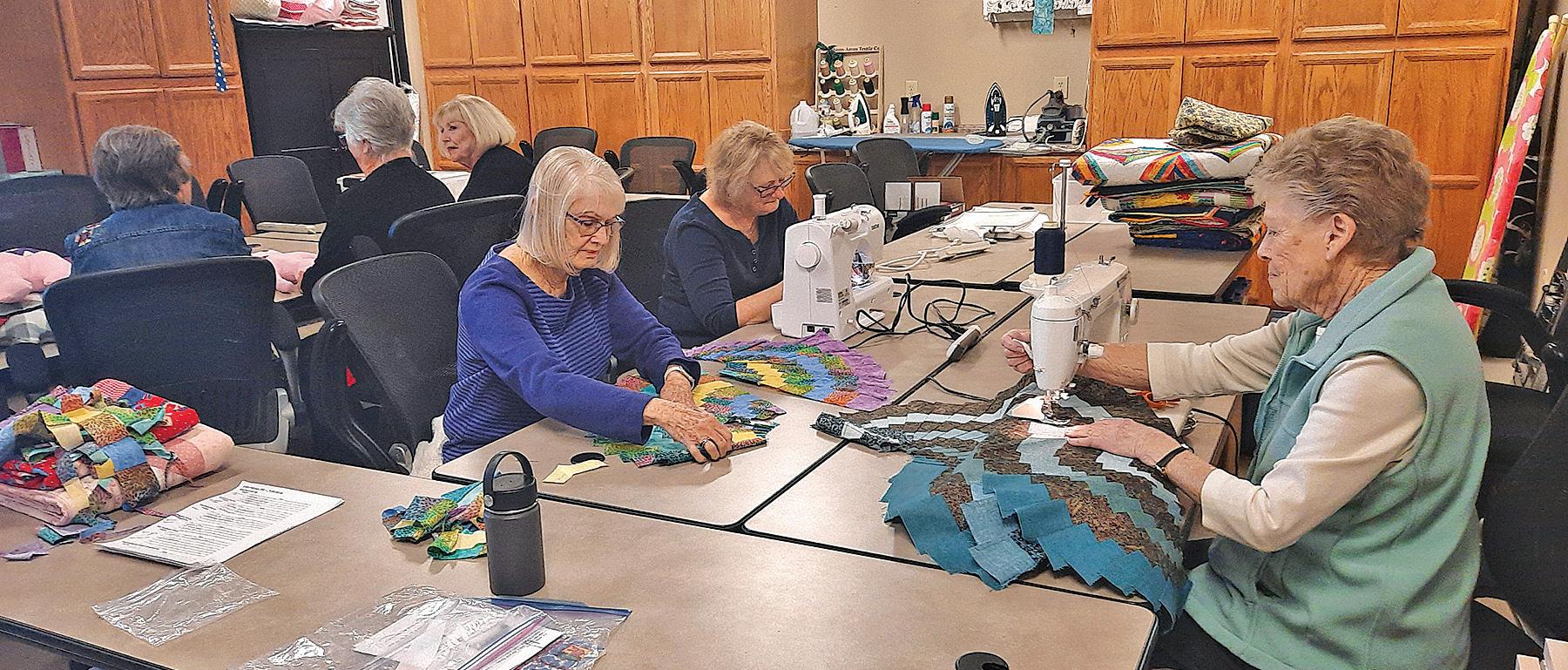
“There is joy in creating things for others, knowing that someone is benefitting from this while we have the comradery of sewing with others,” said Joanne Amico, club co-president.
Quilts on display include Linda Eg-
ner’s Arizona State Fair Blue Ribbon winner. In addition, there will be quilted kitchen items, infant and children’s apparel, linens and other offerings.



“Members generally have a large presence in the shows, but this year will be somewhat limited,” Amico said.

On-going renovations to the regular venue, the Trilogy Ballroom, are prompting the club to spread merchandise across several rooms and limit the number of quilts on show. Some merchandise will be set up outside.

Also scheduled Saturday is the car show that the Trilogy Community Association started running alongside the quilt show four years ago.

“We started this so the women could go to the quilt show and the men could go to the car show and they would both be happy,” said Robin Crawford, lifestyle director at Trilogy. “However, it seems the women like the car show as much as the men.”
This year’s showcase will include a 1929 Ford Model A Roadster, 1939 Graham Sharknose, 1948 Chevrolet Wood-

ie Convertible and 1930 Ford Model A Coupe among the older models. Basking in a shiny new glow are a 2018 Ferrari 488 and a 2023 Chevrolet Corvette C* Stingray Convertible.
DJ Laurence the Brit will play music from the 1950s-70s and the Tennis Club will sell hot dogs.

Creating the quilts is labor-intensive, but club members do not seem to mind.
Drawing from the 2,035 homes in the community, the club has an active membership pushing 60, plus 13 retired members known as “friends of quilters” who extend a hand now and then.
Many reside in Gilbert during the winter and leave for their home states in the summer but continue sewing there and bring the items back when they return.
“We sew all year round with full time Trilogy members, often in the air-conditioned San Tan room and studio working all summer,” Amico said.
Mondays are special.
“That’s charity sewing day, when we open a larger adjacent room to accommodate the active sewing group which is generally 15 to 20 members, with oth-


ers layering quilts, using the longarm to quilt and possible others organizing upcoming projects or keeping the fabric organized,” Amico said.
Fabric and supplies are often donated, but purchased as needed.
“Members often share fabrics from their ‘stash’ and feel good about it,” Amico said. “At least twice a year, ladies fill up cars and head off to the charities with donations, vote on money to be given to other charities and feel so fulfilled knowing they had a part in making it all possible.”
Some of the benefitted charities are Sunshine Acres, Arizona Kids, Lutheran Social Services, New Life Pregnancy, Saint Mary’s Food Bank, Band of Angels, and TPR Foundation, which provides meals on wheels and lock boxes for houses with elderly residents.






Amico, who has shared her club president duties with Jean Perin for two years and with Linda Coll for a year earlier, said she has been quilting since she was 12.
She sewed clothes first for herself and then later for her children and grandchildren.
She began quilting with the Trilo -


gy group about seven years ago, often learning new techniques.
“While there are obviously overlapping skills, I had to learn new techniques, experience how to organize fabric for a quilt and then the finishing of a quilt,” she said. “The club has a longarm quilting machine which I eagerly learned how to use. One day, someone brought in an embroidery machine and I jumped at the chance to learn it.”
Despite occasional nicked fingers and the constant need for more well-lit areas and updated eyeglasses, the women share a passion and drive to create. Most work in the studio and then take their projects home to continue.
“At the end of the day, you can spend as much time and energy as you have and get back energy from the collective spirit of the group,” Amico said.
Trilogy Quilt Show and Country Store from 10 a.m. to 3 p.m. on Saturday, Feb. 25 and the Antique/Classic Car Show from 10 a.m. to 1 p.m. A raffle for a quilt will take place at 2:30 p.m. and people do not need to be present to win. Admission is free to both events.

It’s not a secret that the jobs of the future are going to require a heavy dose of science, technology, engineering and math education.
“We have to keep producing more career technical education, more STEM, STEM, STEM, STEM, STEM, STEM,” Chris Camacho, the executive director of the Greater Phoenix Economic Council, told Chandler City Council in January. “That is critical for our state’s competitive position.”
A new after-school business has opened up to help.
iCode held its grand opening in Chandler on Feb. 4, with other schools planned in Gilbert, Scottsdale and Goodyear.
iCode started in 2015 and began offering franchises in 2018. Five years later, it has about 70 locations and the Chandler school is the first in Arizona.
“It’s meant to supplement, not take the place of, the regular school,” said Misty Ellis, who owns both the Chandler and Gilbert locations with her husband, Daniel.
“What we provide here is something that most schools don’t provide. It’s education, but really with the technology. We do a huge focus on soft skills.”
Misty, whose husband works in cybersecurity, said they wanted to own their own business and started shopping around for franchise opportunities.
“When he saw the iCode curriculum, he was like, ‘This is it. This is what I want to do,’” she said.
That curriculum is the main drawing card.
The school hires college students who are finishing up their STEM degrees as instructors. Ellis said her instructors have said they wish they would have had an iCode school when they
were young.
The couple hopes to open up their Gilbert school by the end of February
with a grand opening there likely happening in March.
iCode offers programs for students from kindergarten through senior year of high school, separating the programs by using the martial arts belt system. A white belt is for robotics; yellow, app development; orange, web development; red, game development; green for drones, blue for networking and black for cloud computing.
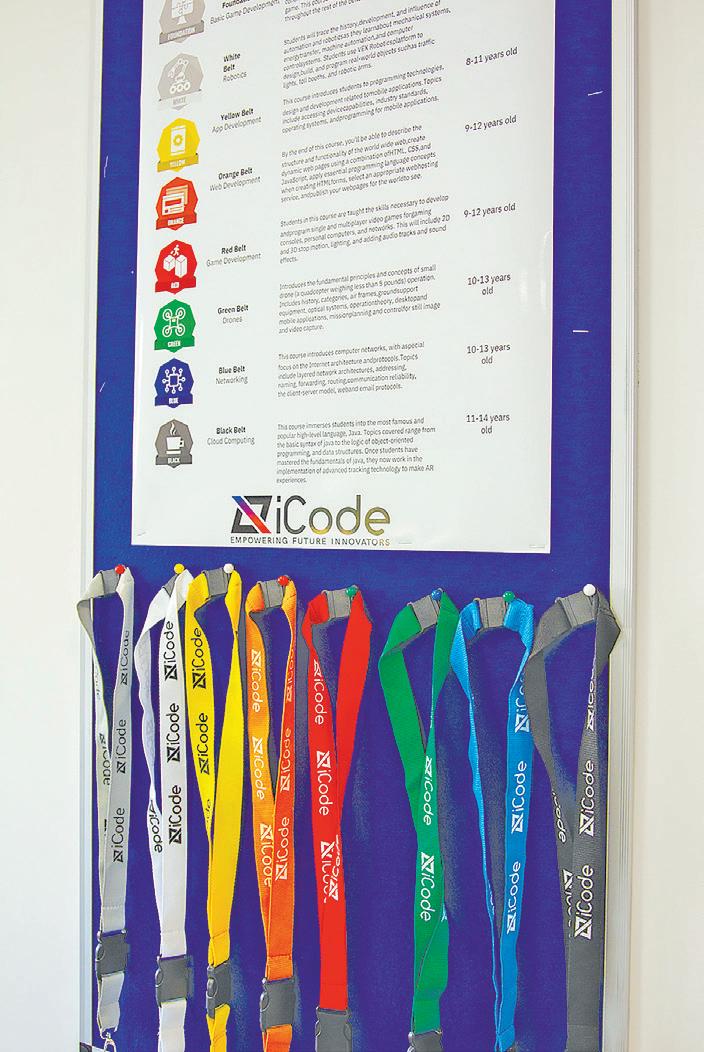
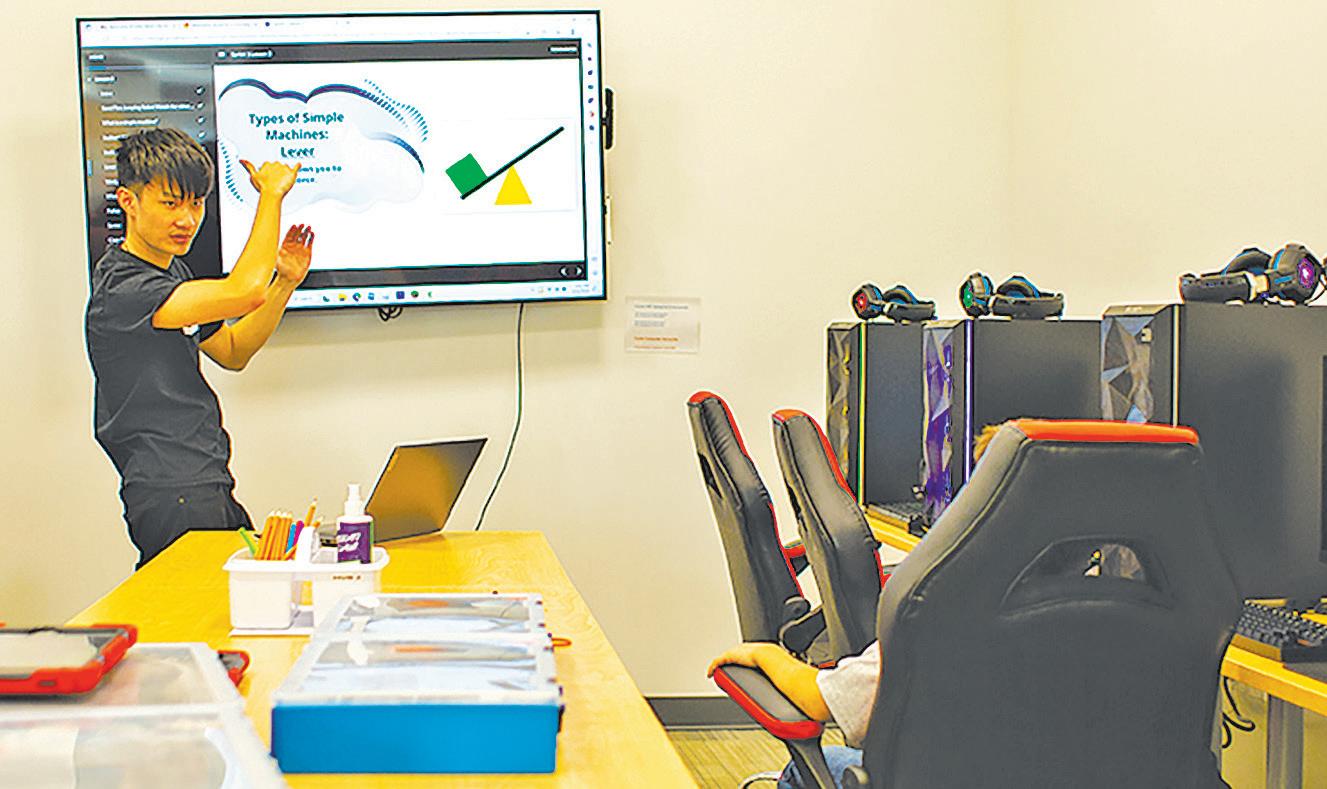
The key to making this succeed, Ellis said, is that the students have to want to learn. So iCode makes the programs fun so they look forward to coming to class.
“This makes it fun, it makes it engaging,” Ellis said. “And the kids have a great time. We really focus on soft skills problem solving. They are always learning how to give presentations and to share what they’re learning.
So they’re not just sitting in front of a computer, they’re learning how to write code.”
iCode has a number of options. Most regular classes meet for two hours once a week though there also is an option
with two one-hour classes. In addition, it provides special camps during the summer and breaks in the usual school-year schedule.
Ellis said they would also like to partner with local schools, running an event at their campus at no charge to give parents a chance to know about their program and see what the program offers.
She said so far, they’ve had more luck partnering with charter schools than they have with public school districts.
The most popular hub at iCode, Ellis said, is the gaming hub. She and her husband choose games specifically for the education value, such as Minecraft and Roblox.
“We don’t just set a kid in front of Minecraft and say, ‘oh, have fun,’” she explained. “We teach them how to modify it, how to do mods, how to change different things in the game.
“Then we can teach them how to create their own games. So just it’s a really great supplement to what they would get at school.”
Ellis said the goal of the program is to give students a solid STEM foundation by making learning fun.
“They really work hard to make it engaging, because we don’t want any kid coming in and sitting here and just being like, ‘Oh, I hate this, like, my dad’s making me do this, because he’s a computer science guy,’” she said.
“We want it to be fun, and very hands on. So, you know, we added a lot of hands-on activities.”
1960 W Germann Road, Chandler 480-222-8991
3115 S Val Vista Drive, Gilbert 480-222-8990
icodeschool.com





































































































efore Tinseltown’s glitterati descended on the Valley of the Sun for Super Bowl 57, an inhabitant of “Hollywood for the cosmetically challenged” preceded them. One of Washington, D.C.’s “celebrated public servants” stood before a multitude of microphones and cameras five days before the big game.
And talk about an acting job!
To hear Department of Homeland Security Secretary Alejandro Mayorkas hold forth, you would have thought that a motion picture portrayal akin to Pat O’Brien as Knute Rockne – or a performance recalling that old made-for-TV movie with Ernest Borgnine as Vince Lombardi – was in production.
What has made Joe Biden’s selection
of Mayorkas unbearable for many residents of this border state is his unflagging effort to erase the international boundary that supposedly exists along our southern state line.
BIt even led Arizona’s 5th District congressman, U.S. Rep. Andy Biggs, to file articles of impeachment against him six days prior to his latest visit.

“Every day Secretary Mayorkas remains in office America becomes less safe,” said Biggs.
Perhaps to prove that our nation is the “land of second chances”—not to mention third, fourth, and fifth opportunities for chronically criminal border crossers—Mayorkas played the part of “Mr. Enforcement” when he addressed the press.
Of the efforts to secure Glendale’s State Farm Stadium, Mayorkas said, “We screen everything that comes into this stadium…not just the people, but the food, the concessions…we screen every-
thing!”
The media passed along this headline: “Homeland Security Secretary Mayorkas says there is no credible threat against Super Bowl in Arizona.”
Of course, the same cannot be written about the border—if we can still truly call it a border.
It seems the worldview of Sec. Mayorkas and others of his ilk was reflected in the graffiti scrawled across a wall meant for messages instead of security: “Borders are scars upon the Earth!”
Nope.
Borders are reasonable and rational lines of geopolitical demarcation between and among nation-states for their mutual security and sovereignty.
As President Reagan put it, “A nation that cannot control its borders is not a nation.”
Sadly, that basic truth is willfully ignored by Mayorkas.
How else to explain his failure to rec-
ognize that if the same screening in place at State Farm Stadium for the Super Bowl—as well as the military and law enforcement personnel needed to conduct it—were likewise present along our southern border, it would likely result in a similar outcome: no credible threat. Instead, Mayorkas is similar to a muttering motivational speaker—insisting to himself and the rest of us—that this crisis is a “threatening opportunity.”
We need to take Mayorkas literally. That’s why that when he testifies on Capitol Hill, he repeatedly says, “Things are going according to plan.”
And it’s also the reason he discounts the obvious threats to embrace “opportunity.”
Nothing matters more to Mayorkas than a mass amnesty that would make millions of illegal aliens into instant American citizens.
see HAYWORTH page 18

The news caught my eye late on a mid-February morning: Actress Raquel Welch had died at the age of 82. If you are an adult of a certain age – and especially a male– you surely can close your eyes and conjure visions of Raquel, who was to Hollywood sex symbols what John Adams was to presidents – second in line.
In Welch’s case, behind only Marilyn Monroe when it came to earning headlines not for her acting talent, but for the way she looked. This isn’t to say Welch was untalented – she won a Golden Globe for her role in “The Three Musketeers” – but more to give credit to her
beauty, which was otherworldly.
It’s considered politically incorrect to comment on female attributes in the 21st century, but there is no way to think about Welch without acknowledging the obvious. As a beauty, she had few peers.
In 1998, when Playboy magazine made a list of the 100 sexiest female stars of the 20th century, Welch placed third, behind Monroe and Jayne Mansfield and ahead of Greta Garbo.
Me, I think Raquel got robbed by the judges. Not merely because I had a teenage crush on her, but also because Welch accomplished something precious few sex symbols have ever done: She went her entire movie career, from her first role as a call girl in 1964’s “A House Is Not A Home,” to her last movie, 2017’s “How To Be A Latin Lover,” without ever once appearing nude in a movie.
“I’ve definitely used my body and sex appeal to advantage in my work, but always within limits,” Welch once said. “I reserve some things for my private life, and they are not for sale.”
Nowadays we live in a time when nudity is never more than a click away, and OnlyFans, webcam shows and YouPorn have made cashing in on being naked the easiest side hustle imaginable.
By contrast, Welch embodied a sense of mystery and a sense of decorum that died many, many years before she did.
Now? Selling and sending nudes has become little more than a hobby for the masses. We are urged to be thankful for this newfound liberation, but somehow Raquel Welch managed to strike a balance between feminine power – think of her in that famous deerskin bikini from the poster for “One Million Years B.C.” –
and feminine modesty.
Even when Welch finally appeared in Playboy in 1979, she stripped down only as far as a red bikini. My father kept that issue hidden on the top shelf of his closet, a hiding spot I will confess to visiting on many occasions.
Speaking of fathers, Welch said her dad was another reason she never appeared nude.
“I am my father’s daughter and that’s just not the way you behave,” she said. “You don’t do that if you are a certain kind of a woman and that’s the kind of woman I was raised to be.”
As legend would have it, Playboy publisher Hugh Hefner summoned Welch to his mansion after the photo shoot to complain.
HAWTHORN from page 17


Biggs points out that the Secretary’s “policies have incentivized more than five million illegal aliens to show up at our southern border—an alltime figure.”
But as gratifying as the impeachment of Mayorkas would be, the sad fact is that the Democrat-controlled Senate would not vote to convict and remove him from office.
That’s why the best course for the House would be to pull on the purse strings and reduce funding to both the Department of Justice and the Internal
Revenue Service.
If the operating budgets of both those entities were reduced by 25 percent each and reallocated for genuine border enforcement during the appropriations process, it would prompt positive results.


Of course “enforcing that enforcement” would have to come through aggressive and constant oversight. Otherwise, Mayorkas would seek mere cosmetic changes to maintain the ugly truth of a wide-open border that imperils the security of every law-abiding American.
And it’s not a game.
LEIBOWITZ from page 17
As Welch recalled the meeting: “I said, ‘What’s the problem Hugh?’ and he said, ‘Well there’s no t–s and there’s no a–’. I said, ‘Isn’t that the deal we made?’ He said, ‘Yes, but it’s boring.’”
It seems quaint now, the notion that modesty ever existed and that it was once possible to be sexy – in fact the sexiest woman on Earth – and to keep certain assets and certain images to yourself.
Somehow, Raquel Welch managed to shock without being shocking, to be sexy without being lewd. In 2023, the

E-mail: pmaryniak@timeslocalmedia.com

age of the Kardashians and Pornhub, that seems like a trick we may never glimpse again.
Queen Creek Tribune welcomes letters that express readers’ opinion on current topics. Letters must include the writer’s full name, address (including city) and telephone number. Queen Creek Tribune will print the writer’s name and city of residence only. Letters without the requisite identifying information will not be published. Letters are published in the order received, and they are subject to editing. Queen Creek Tribune will not publish consumer complaints, form letters, clippings from other publications or poetry. Letters’ authors, not Queen Creek Tribune, are responsible for the “facts” presented in letters.
































The growth of girls’ flag football as an official sanctioned sport in Arizona high schools has been monumental.
What was once a club sport was fast tracked to sanctioned status, which opens the door for more schools to participate and the ability to crown a true state champion at the end of the 2023 fall season — when it kicks off for the first time.
The Arizona Cardinals took notice of efforts from districts like Chandler and Mesa to grow the sport, awarding CUSD $10,000 last year for equipment.
But perhaps the biggest show of support for the sport in Arizona came Friday, Feb. 10 during the NFL Stakeholders Breakfast in downtown Phoenix two days before Super Bowl LVII. It was there AIA Executive Director David Hines was presented a check for $100,000 as part of the girls’ flag football product grant from Nike.

“It’s just absolutely fantastic,” Hines said. “To work with the NFL, the Cardinals, Nike and their support of girls’ flag football. They’re really invested in this, and we’re invested in this, too. It’s really going to create opportunities.”
The grant comes at a time where schools are mulling options of how to field teams in the fall.
The last official season for girls’ flag football as a club sports — which it has operated as for years — kicks off in March. In the fall, however, more teams will participate, and a state tournament will take place to crown a state champion.
But a new sport means new costs. The grant, however, will offset some of that. Hines said as many as 33 schools will have the opportunity to use the money to purchase 25 uniforms.
“We are going to have 33 schools be
able to pick their colors, design it for 25 kids, which is absolutely terrific,” Hines said. “We’ll try to take care of as many schools as we can.”
Chandler schools, having been the pioneers of the girls’ flag football movement, are already equipped with uniforms. The district also provided AllStar jerseys for the girls during a special game last August in which Cardinals linebacker Markus Golden helped coach.
The Mesa district also reaped some benefits from the Cardinals support.
Riczer Desvaristes, the manager of youth and high school football for the Cardinals, was on hand during the Mesa city Tournament along with his team to help crown the champion. Other schools like Xavier and some in the Tempe Union district have already established a girls’ flag football team on campus.
Hamilton coach Matt Stone hopes the money will provide opportunities to girls at schools that don’t have the same resources as others. His goal from day one was to give every athlete in Arizona an opportunity to play.
“This is the green light the rest of the state needed to know that this is a serious movement,” Stone said. “This is not a club sport anymore. Our projected numbers in the years to come are substantial. I think any school that was on the fence, this can help tip them over toward playing next fall.”
Like Stone, Casteel coach Rae Black aims to provide opportunities for girls at her school and beyond to play flag football.
She’s been one of the leading voices ahead of the charge, promoting the sport around the state. She was in attendance when Nike gifted the money to Hines and the AIA. Soon after, she went up and personally thanked Nike’s Matt James.

“It just goes to show how serious Nike is actually taking it,” Black said. “They’re the ones reaching out and wanting to make friends with us. I think that’s awesome for people to support young women’s dream as part as playing football for your school.”
The growth of girls’ flag football has been beneficial for all athletes involved. Thanks to Desvaristes and the Cardinals, Jesus Arzaga’s Mountain View team was granted the opportunity to attend NFL Honors, the league’s annual awards show, as well the NFL Experience during Super Bowl week at the Phoenix Convention Center.
Arzaga, who also coaches the Toro baseball team, hopes the money from Nike can be used for more than just uniforms for schools in need. He hopes the
support will also draw in coaches.

“Maybe get some interest from coaches and girls to want to do it a little more,” Arzaga said. “I think the toughest part of being in the fall, or even the spring, is getting coaches involved. Hopefully that money intrigues some of the coaches, gets some girls out and continues to help schools that need it to continue the growth of girls’ flag football.”
Mesa schools currently await the start of the first-ever season as a sanctioned sport for girls’ flag football in the fall. Chandler, meanwhile, along with other districts, will play a spring season beginning in March.
It’ll be a dry run of sorts for the real thing, with the AIA providing officials for games. But the excitement level has never been higher.
“We knew there was a lot of support but the amount of engagement of our schools with kids wanting to get involved and kids wanting to get involved, really fast-tracked it,” Hines said. “What I look forward to down the line is we add a new division or conferences as we move forward and continue to build.”



 BY KEN SAIN GetOut Staff Writer
BY KEN SAIN GetOut Staff Writer
There were times in the past three years when Huss Brewing Company considered getting out of the Spring Training business.
“We did have some hearts-to-hearts about it,” said Chip Mulala, the director of operations for the company, which sells its local craft beers at seven of the 10 Cactus League stadiums.
The past three years have hurt businesses and frustrated baseball fans who like to visit Arizona in March for the nice weather and Spring Training games.
First, the COVID pandemic forced an end to nearly all sports in mid-March 2020, abruptly ending a strong Cactus League season. In 2021, stadiums had to deploy social distancing, limiting capacity to 50%. Plus, they started late and had fewer games.
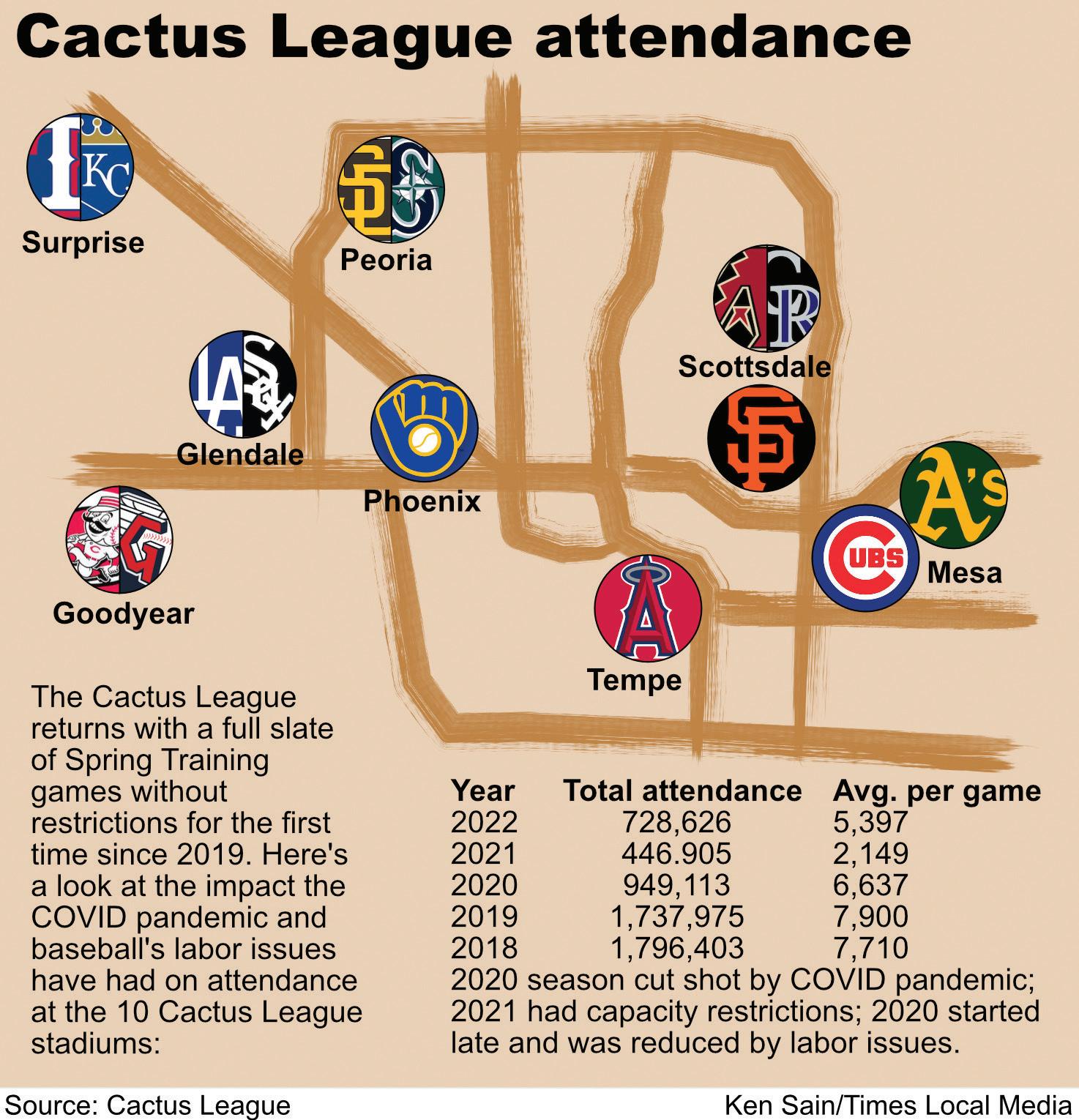
COVID was not a problem last year, but Major League Baseball’s labor dispute was. The owners locked players out until they reached a new collective bargaining agreement, forcing a late start and fewer Spring Training games.
In 2019, there were 220 Spring Training games played in Arizona, drawing 7,900 fans per game. The number of games dropped to 143 in 2020, hit 208 with the limited capacity in 2021 and bottomed out at 135 last year.
The impact those three years had on the state’s tourism and the industries that support it is still being felt.
“It made something abundantly clear,” said Steve Chucri, the president/ CEO of the Arizona Restaurant Association. “Spring training is crucial to a lot of restaurants.”
The Cactus League schedule begins on Feb. 24, and for the first time since 2019, a full slate of games awaits with no capacity restrictions.
“In 2023, we are looking forward to
a ‘normal’ season,” said Bridget Binsbacher, executive director of the Cactus League. “Combine that with an upswing in tourism and I’m optimistic we will see much higher attendance. Everywhere I go, people tell me how excited they are to get back out to the ballpark.”
There are 15 Major League Baseball teams that train in the Valley, playing their games at 10 stadiums. Five ballparks are home to two teams.
Most of the stadiums are supported by local charity groups, such as the Thunderbirds in Scottsdale and the HoHoKams in Mesa, that raise money and then spread it around to local charities.
The charities’ ability to do that has been hurt during the past three seasons.
Binsbacher said before 2020, the Cactus League generated $644 million annually for the local economy. In 2020, that dropped to $363.3 million. The league does not have the numbers for the past two years yet.
One Scottsdale based-business, Bella Palazzo Collections, rents out private homes. Owner-operator Margie Van Zee said MLB’s labor issue last year was the hardest on her business.
Many of the people renting some of the 80 homes in her collection are ballplayers.
“We had to have a cancellation clause in our contract so that if MLB continued to obstruct the ballplayers, then they could get out of it,” Van Zee said, adding that it forced her to be more flexible.
Ironically, the pandemic’s onset in 2020 led to an increase in business.
“2020 was the best year we’ve ever had, even during the pandemic,” she said. “What happened was nobody wanted to go back to their hometown. They were already here for spring training, COVID happened. A lot of them would have to go back to their cold weather climates and areas that were still shut down.
“So, a lot of the ballplayers just said we’re extending, many of them extended and stayed till the beginning of the year.”
Mulala said Huss Brewing Company decided to stay in the Spring Training business. In fact, they just opened a new location – Papago Brewing Company, close to Sloan Park in Mesa where the Chicago Cubs play.
“We actually have it set up that we’re going to have a shuttle that is going to be taking people to the games on game day for most games that start at one o’clock,” he said.
While the past three years have been
difficult, right now is a great time to be in the restaurant business. In addition to Spring Training, the Super Bowl and Waste Management Phoenix Open were also in town.
All those events brought a lot of tourists. Chucri expected to see between a 20-to-25% increase in sales just because of the Super Bowl.
“The restaurant economy, for all of our hopes and desires this February and March, is going to be very, very much needed,” Chucri said. “[We’ll] really get a huge boost when it comes to these these big events coming to the state, especially Spring Training.”

 BY JOSH ORTEGA GetOut Staff Writer
BY JOSH ORTEGA GetOut Staff Writer



With Spring Training just around the corner, Huss Brewing Co. is ready for thirsty fans at its new Papago Brewing Company taproom at Mesa Riverview – realizing a dream of owners Jeff and Leah Huss. The taproom, occupying the former home of The Brass Tap at 1033 N Dobson Road, is inside a standalone 2,100-square-foot, 104-seat taproom and restaurant that will pour an ever-changing selection of 60 craft draft beers, plus packaged beers to-go. Its opening earlier this month coincided with Huss’ refresh of the Papago brand. Leah Huss spent 14 years as co-owner of the original Papago Brewing Company in Scottsdale and helped pioneer the local craft beer scene, including the creation of Papago’s signature beer, Papago Orange Blossom. Leah and her husband Jeff Huss made the new taproom a personal passion
project and said she long dreamed of reintroducing the Papago Brewing experience to the East Valley – not with a

rehash or a replica of the old taproom, but a brand-new iteration.
“I really wanted to envision what Papago Brewing would look like in 2023,” Leah said. “So, we’ll still have elements







the next month-and-a-half when Cubs fans will fill nearby Sloan Park as part for Spring Training.

Starting on Feb. 25, Papago will open for lunch at 11 a.m. and offer free shuttle from Papago Brewing Co. to Sloan Park for those attending Cubs Spring Training games.


MaLeea Cole-Briggs, Mesa Riverview property manager, said called the taproom a welcome addition to the center coming at an opportune time.
“The opening of Papago Brewing Co. couldn’t have been better timed,” Cole-Briggs said in a statement. “The pub’s wide selection of craft beers and old-world ambiance will provide a comfortable gathering space that we are sure our guests, including the area’s top sports fans and tourists, will heartily embrace.”
Leah and Jeff Huss have 35 years of combined experience in the brewing industry.


Jeff, a former head brewer for BJ’s Brewing in Chandler, attended the Siebel Institute in Chicago and the Doemens Academy in Munich, Germany.
Huss Brewing Co. opened in 2013 with taprooms inside the Tempe brewery.
small-batch and experimental beers. It includes past favorites such as Elsie’s Milk Stout and Hopago IPA, all paired with a compact menu of premium bar bites like the sausage and pretzel board as well as 12” pizzas, paninis, sandwiches and salads.

Most important, Leah said they’re excited to build on the solid craft beer foundation built by Brass Tap owners Jesse and Jason Rowe.
“They’ve been great stewards of the Mesa craft beer scene, and we’re excited to introduce Huss and Papago to the neighborhood,” she said.
The quiet locale at Mesa Riverview runs contrary to what’s happening for the rest of their locations – especially their taproom inside the Phoenix Convention Center.
Brewmaster Jeff Huss – a diehard Chicago Cubs fan – looks forward to

In 2016, Huss acquired the Papago Brewing Company in Scottsdale, creating the newly formed Huss Family of Beers and transforming Huss into the third largest brewer in the state.
Although the Scottsdale taproom eventually closed, Leah and Jeff Huss made sure Papago’s pioneering spirit lived on, purchasing Papago Brewing Company in 2016 and expanding the product line to include Papago Cherry Blossom and the brand-new Papago Blueberry Wheat beers.

And now approaching nearly two decades of existence in the Arizona marketplace, Huss has taken the iconic brand to the next level with newly designed cans.


“This refreshing and iconic brand is almost 18 years old, so we wanted to give it a bright and fresh new feel,” Leah Huss said. “The new cans really showcase the oranges and refreshing nature that has made Papago Orange Blossom one of Arizona’s favorite beers for almost 2 decades.”

HIRING NOW FOR:
• General Laborer
• Shipping & Inventory
Crane Operator
• Maintenance
Mechanics/ Electricians
• Production Operator
And more!
CMC Steel Arizona has proudly been making the steel that builds America since 2009.
We are hiring immediately for all skilled operator positions to be part of building our new, state of the art micro mill from the ground up!
At CMC, we offer great benefits and provide all necessary training and certifications.
Scan to see all job openings!






























































